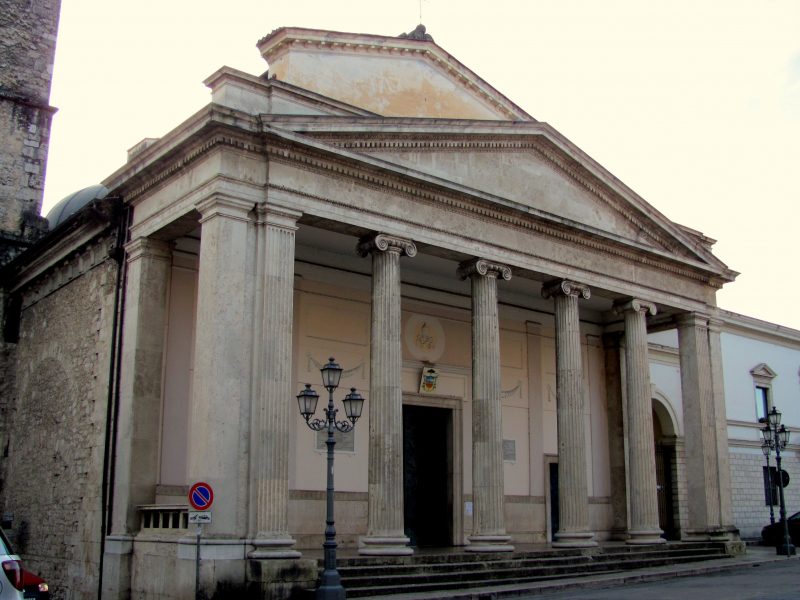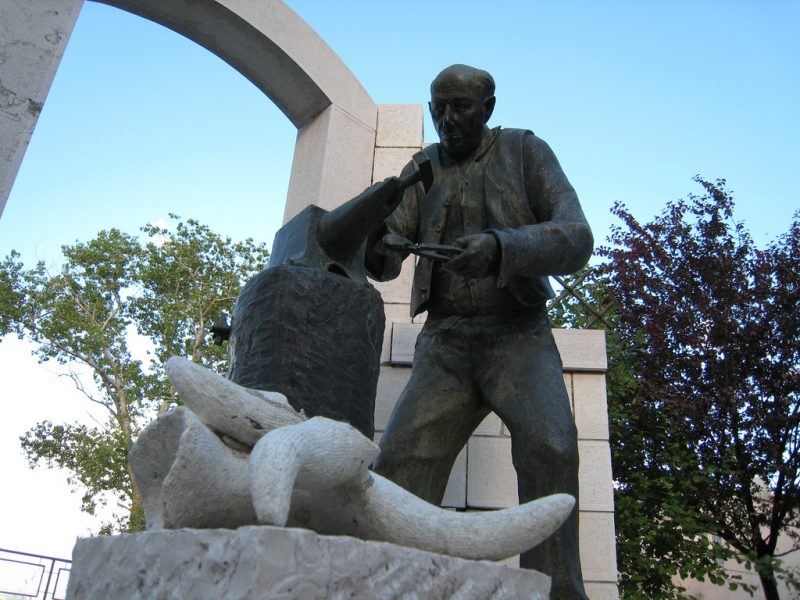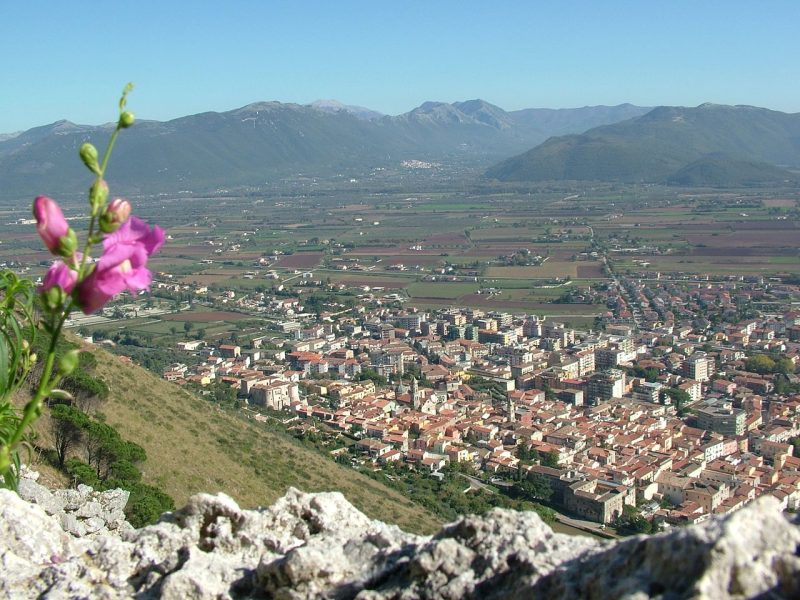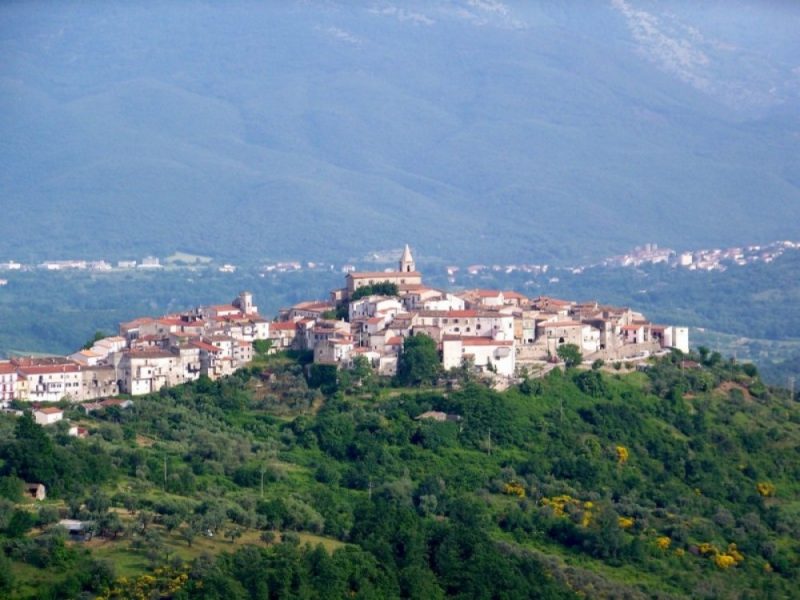The Borgo of Agnone
The chiming of the bells reverberates through the streets, their golden tones expanding through the green leaves of the woods, floating up into the hills and echoing across the red rooftops of the town.
In Agnone, the Marinelli Pontifical Foundry has been producing bells for over a thousand years, and for each bell, dedicating the same love and devotion as to the birth of a child. Marinelli’s bells are in every bell tower in the town, and in Agnone, there are twenty bell towers, rising majestically over the ancient buildings and bustling lanes of the village. The streets have a Venetian flavor, with majestic stone lions placed all around the borgo, sometimes where you would least expect it.
Agnone is the city of ‘the unique’, with Medieval artisan workshops that produce exclusive creations of rare beauty, authentic expressions of the community of the borgo.
The many traditions of this borgo in Alto Molise are also unique. It is always beautiful here, but it shines even more at Christmas time, when the extremely ancient ritual of the ‘Ndocciata is enacted, with almost all the inhabitants carrying enormous flaming torches, in a mystical river of fire that attracts thousands of visitors to this little town every year.
It was certainly no accident that Pope Giovanni Paolo II fell in love with this place, saying before he left, “Valeva la pena di venire qui.” (“Coming here was worth the effort.”)
History
Morphological studies carried out in the territory of Agnone discovered the original nucleus of a settlement near the Church of San Marco, currently the main church, which subsequently expanded to the area where the Baronial Palace now stands, and it is the influence of these two centers of power that have determined historical development of the borgo.
Although there is no absolute certainty about the foundation of the city, a local tradition maintains that the ancient city of Agnone corresponds with Aquilonia (the town of eagles), a Samnite village destroyed by the Romans in their ‘expand and exterminate’ campaign in Samnite territory.
The advent of the Lombards in Italy from 568 to 774 A.D. brought about a period of prosperity for Agnone, which then underwent a steady decline that peaked around the year 1000, the same period in which monasteries and small farming communities formed in the surrounding hills.
A Venetian wind of change came to Agnone in 1139 with the arrival of the Borello family, originally from Pietrabbondante, who had been in service to the Doge of Venice, and who brought an entire court of Venetian soldiers and artisans to the borgo. Their arrival corresponds to the ‘official’ founding of the borgo, a ceremony that was held on Mount Caraceno, in the area that now corresponds to the Ripa quarter, the most ancient neighborhood in the borgo, which is commonly called the ‘Venetian borgo’.
Historical sources indicate that the city was called “Angolum”, which then became Agnolum, and finally, by 1507, Agnone, according to documents of the era.
The era of Angevin rule in the 1200’s, and the Aragon domination starting in the 1300’s, saw a period of development in Agnone that continued on until the era of the Kingdom of the Two Sicilies, when the Bourbon sovereigns reinstated Agnone as one of the fifty-six royal cities, therefore free from the bond of feudalism. This new status meant that Agnone was directly under the King’s control, exempt from local feudal taxes, and furnished with its own court, which was even authorized to sentence capital punishment.
The 1800’s brought flourishing cultural development to Agnone: the streets of the borgo were full of artists, philosophers, theologians and writers, and this thriving intellectual wealth earned Agnone the title of “the Athens of Sannio” (Sannio being the ancient name of the region).
The industrial revolution provoked a crisis in the price of goods, which destabilized the economy of the town and led many residents to emigrate to America and Northern Europe. Nonetheless, Agnone continued its cultural ascent, and even installed public lighting in the town before Rome itself was able to do so.
The first half of the 1900’s were dark years for the city, which was often chosen as the location to imprison Mussolini’s political opponents. In 1940, by decree of the Bishop, the Monastery of San Benedetto was transformed into a concentration camp, where Jews, dissidents and especially the tribal group “Roma”(or gypsies) from ex-Jugoslavia, were imprisoned. The doors of the prison camp only opened again on September 8, 1943.
After a spurt of growth in the post war period, Agnone’s development progressively slowed during the 1950’s. Today, the city is experiencing a new dynamism thanks to the numerous visitors who come to the borgo to go horseback riding, be in contact with nature, and most of all, to explore the beauty and fascination of this timeless borgo.
The Church of San Marco
Agnone is a small village but it is full of churches, evidence of the prosperity the borgo enjoyed in the past. Among them all, the most important is the main church, dedicated to St. Mark the Evangelist.
The church stands at the highest point of the historical center, in an area which has been inhabited since time immemorial. Local tradition attributes its construction to the Borrello family, but no documents attesting to this have ever been found. The church suffered two devastating fires, the first in 1390 and the second on Christmas Eve in 1610. In the second fire, the original Benedictine church with its three naves was completely destroyed, and in its place a new church with a single nave and a single entrance was constructed.
The external façade of this new church is simple and linear, with no hint of the wealth of decorations inside. The Renaissance style portal opens onto an interior in full Baroque glory. The single nave is flanked by two semi-colonnades dividing the space, and the lateral walls are graced with marvelous carved wooden altars painted in gold. The Church of San Marco is full of prestigious paintings and statues all finely carved in wood with the exception of the statue of San Cristianziano, which was made in papier machè over wood. Of particular importance is the organ, which was the first in the Molise region, made by local master craftsmen, and the monstrance, which contains the host, dating back to the fifteenth century, created by the goldsmith Giovanni Rizio.
Thanks to an archpriest in the 1800’s, we have a reproduction of the wooden roof, decorated with prestigious paintings. The original was destroyed in one of the fires, and this gift certainly brings an extra touch of beauty to the church.
The Church of Sant’Emedio and the “Emidiana” Library
In the Middle Ages, it was customary to build churches to honor the promises made during vows to saints or the Madonna. The Church of Sant’Emidio, built in the fifteenth century, is a case in point.
The worship of Sant’Emidio of Avingnon was widespread in the thirteenth century, following several earthquakes that damaged the city and forced the citizens to rebuild their homes. The weary faithful had made a vow to Sant’Emidio, the protector of unsafe situations.
The Church of Sant’Emedio is a Medieval Church, but the facade has some contaminations in Gothic style, which is especially evident in the portal. These Gothic elements were donated to Agnone by a group of merchants from Ascoli, who frequented the city to trade fabric.
The interior is full of prestigious works, such as the Crucifix, created in the 1500’s and characterized by the stunningly realistic perfection of Christ’s body. The wooden statues behind the main altar are from the 1500’s, and are part of the most famous work in the church: a three dimensional depiction of “The Last Supper” with life-size statues of Christ and the disciples.
The altar dedicated to the Holy Family is also of great prestige, and unique in its kind, because in the central painting, instead of the usual nativity scene, there is a depiction of the event of the Jesus’s circumcision, considered important because it represents the first blood shed by Christ for humanity.
Another exceptional piece in this church is the Christ on the Cross, created by Giulio Monteverde.
Next to the church, is the “Emidiana” library, which holds one-of-a-kind literary works. The most ancient are parchments dating back to the 1300’s,and there are also volumes of books from the 1500’s, 1600’s and the 1700’s, as well a valuable document created by San Bernardino da Siena.
Chiesa di San Francesco, The Church of St. Francis
The Church of San Francesco is considered the most beautiful in the borgo. It was built in 1343, but it underwent exhaustive remodeling in 1732.
Numerous traces of the original construction can be found in the façade, which was created with squared blocks of compacted limestone. At the entrance there is an arched portal, with geometric and floral decorations, and above it stands a central rose window, which over the centuries has undergone numerous restorations, with some modifications to the original features.
The interior is in the Latin cross layout, characterized by an opulent Baroque style, sporadically embellished with Renaissance decorations. Along the side walls there are eleven chapels, with their eleven altars, decorated with elegant garlands of stylized flowers and fruit. Some of the paintings in the church are of particular prestige, created by Pietro Gamba, a renowned Molisan artist, as well as a marvelous panel depicting the Assumption, dating back to the 1500’s. Among the altars, the one dedicated to San Crescenzio is particularly magnificent, with its wealth of extravagant decorations.
Ex Convento di San Francesco e Biblioteca Comunale, The Ex-Convent of St. Francis and the Public Library
The Church of San Francesco was built by the Friars Minor, who lived in the nearby convent. In respect of the Franciscan doctrine, the convent has no decorations or embellishment, with the exception of the cloister, which is particularly beautiful in its elegant simplicity. Along the walls there are some marvelous frescos recounting various episodes in the life of St. Francis.
For several years now, the convent has been the site of the Public Library, which contains an extraordinary heritage of rare books, printed between 1512 and 1830 by printing houses throughout Europe, which came to the library thanks to several donations.
To share these cultural treasures with the public, in 2003, the convent held its first ‘Exhibition of Ancient Books’, which attracted more than 5,000 visitors. It was such a success that the exhibition has been made permanent. Of the numerous fascinating works in the collection, of particular interest is an ancient collection of the complete works of Plato.
Museo della Campana “Giovanni Paolo II”, The John Paul II Bell Museum
“De Tintinnabulis”, if you recognize this title, you are a member of the elect, one of the few master artisan bell makers on the planet. Most of us however, certainly have no idea what this Latin term refers to.“De Tintinnabulis” is the sacred text of the art of bell-making, an ancient manuscript which explains the traditional trade secrets and techniques for making bells. This exceptionally rare work is safeguarded inside the ‘Museo della Campana Giovanni Paolo II’, owned by the Marinelli family.
This historic family of Agnone has been making bells since the Middle Ages, and in 1999 founded this museum, which recounts the history of the art of bell-making through the works on exhibit. The rooms of this museum are the proud custodians of the largest collection of sacred bronze bells in the world, and among the many bells on display is “The bell of the year 1000”, the most important of all.
Along the walls of the museum, there is a vast photographic archive documenting the most important events over the last century, as well as the story of the Marinelli family and their close relationship with the Papacy in Rome.
The museum frequently holds conferences and important events related to bell-making, and its library and video-library is open to the public to recount the history and traditions of bell-making around the world.
La Tavola Osca, The Oscan Tablet
The Oscans were an ancient people in Southern Italy, which were later absorbed into the Samnite population. They are considered extremely important from a linguistic standpoint, because their language, Oscan, an extinct Indo-European language of the Osco-Umbro branch, was widespread and spoken by a number of tribes in Southern Italy, including the Samnites.
Over a century ago, near the town of Agnone, a small bronze tablet with a handle was found, covered in inscriptions in the Oscan language. The tablet dates back to around 250 BC and is considered one of the most important testimonies of the Oscan people. Today the original is in the
British Museum in London, while a reproduction can be found on display in Agnone.
The tablet is inscribed on both sides and chronicles a series of dedications to various deities. The front side describes their sacred place to hold rituals and the essential rules for religious ceremonies in honor of the goddess Kerres. The other side lists the divinities and the altars in the sanctuary, and a list of the people who paid tithes and were therefore eligible to enter the sanctuary and participate in the rites.
The tablet was found on Mount Cerro, in a location known as Orto. From the inscriptions, we know that the sanctuary was composed of fifteen altars, where sacred rites were performed on certain days of the year. Every two years a fire was lit which had to burn for the next two years, and during this ceremony, sacrifices were made at the sacrificial altar. Some celebrations were held outside the sanctuary, especially those dedicated to the goddess Flora, as well as some ritual processions.
The tablet also lists the seventeen divinities, all closely linked to the earth, confirming that the Oscan were polytheists. The most important was the goddess Kerres, and the other gods had the task of helping her protect the harvest and the fruits of the earth.
It is no accident that the tablet was found at Mount Cerro, which was named after the goddess Kerres, nor is it by chance that the tablet was crafted in bronze, considered a sacred material used in rituals to honor the goddess.
The Marinelli family and the art of bell-making in Agnone
The Marinelli family has been making bells in their foundry since the year 1000, utilizing ancient techniques and tools dating back to the Middle Ages.
The bells that are created in this foundry are considered living creatures, to be nurtured and coached into their full glory. The process follows a series of phases: the first thing to be created is ‘the soul’, made with a brick interior that is then covered by a layer of smooth clay. Subsequently, the ‘false bell’ is made, with all its decorations, and then the ‘mantle’ is made. Once the first phases are complete, the three elements are divided and melded bronze for the casting is introduced between the ‘mantle’ and the ‘soul’. This is the most important step in the process, and it is performed while praying, like an ancient ritual. For the Marinelli family, the creation of bells is an art of fundamental importance, because the bell represents the voice of God calling humanity to holy union.
The Marinelli foundry is the only one in the world to carry the Papal coat-of-arms, thanks to the initiative spirit of Pasquale Marinelli, who, in 1924 in Pompei, asked Pope Pio XII for the honor of using the sacred emblem. The bond between the family and the papacy is a historic one: with numerous encounters with many popes over the centuries, among them Pope John XXIII and Pope John Paul II, to whom the family still feels great devotion, and who came to visit the foundry in 1995, participating in the casting of a bell, and gathering everyone together for a moment of prayer. In fact, it was to this pope that the Bell Museum Giovanni Paolo II was dedicated in 1999.
Among the many bells they have made, the foundry can boast having created the Giubileo Bell in 2000, which is in Piazza San Pietro, St. Peter’s Square, and weighs 5 tons, as well as the bell of the Abbey of San Cassino, and the bell of the Cathedral of Pompei.
For centuries, the Marinelli family has been the pride of Agnone and all of Italy, and will continue to be so for centuries to come.
La ‘ndocciata, (The Procession of Fire)
The ‘ndocciata is the most important tradition in Agnone, and is so spectacular that it attracts thousands of visitors every year. The ‘ndoccie are fir-tree trunks, which become enormous multiple torches four meters high, tied together with iron wire, and on top, broom flowers, which burst into crackling flames when set on fire.
At sunset on December 24, Christmas Eve, after the ringing of the church bells, the procession of the‘ndocciata begins. The gigantic, blazing ‘ndoccie are carried by the residents of the five neighborhoods, or contrade, of Agnone, and the streets of the entire town become ablaze with roaring trails of fire accompanied by music, acrobatics and other festivities.
This exceptional parade of fire was offered to the Pope himself in 1996, on Christmas Eve, when a river of fire blazed through the streets of Rome, arriving at Piazza San Pietro, in the presence of His Holiness, Pope John Paul II.
The traditional cuisine of Agnone is abundant and varied, composed of the simple and authentic ingredients obtained from the toil and labor of the townspeople: fresh cheeses, cured meats and fresh garden vegetables.
Zuppa alla Santè, Soup alla Santè
It is said that one day a queen passed through Agnone, and she was welcomed by the people with full honors. When lunchtime arrived, the cook was worried that he had nothing to offer the queen, and, terrified of making a fool out of himself in front of everyone, decided to create a single dish with the few ingredients he had available, and the “Zuppa alla Santè” was born.
For centuries, the Zuppa alla Santè has accompanied the holidays and festivals in Agnone, and no Christmas or Easter feast is complete without it.
These are the ingredients for six people:
- 600 gr of hard, day-old bread;
- 5 eggs;
- 300 gr of ground pork;
- pecorino cheese as desired;
- Chicken broth;
- 300 gr of aged caciocavallo cheese;
- Chicken livers;
- A tablespoon of olive oil
- Bread crumbs as desired.
First, beat the three eggs in a bowl and toast the sliced bread. Brush the egg mixture onto the bread and cut into little cubes. Once this procedure is complete, proceed to the preparation of meatballs with the remaining ingredients: meat, the remaining egg mixture, bread crumbs and grated cheese, then, boil the meatballs in the chicken broth.
Next, cut the caciocavallo cheese and the chicken livers into little cubes, and fry the chicken livers in a large frying pan. Finally, add all the previous ingredients into the pan: the cheese cubes, the meatballs in broth, and the cubes of bread. Serve in soup bowls.
As a final touch, you may want to garnish with grated cheese.
Sagne a Tacconi (rhomboid shaped pasta)
The recipe for ‘Sagne a Tacconi’ was recounted by Signora Rosa, from Agnone, who often prepares it for her children. Needless to say, they become ecstatic the minute they smell the aroma coming from the kitchen.
The Sagne (flat pasta) a Tacconi, or Taccunelle, is named for the rhomboid shape of the pasta, which is similar to the ancient pavement tiles of Agnone. It is an ancient traditional dish that has warmed the tables of this borgo since time immemorial.
First of all, make the dough, mixing flour, water and egg, and then roll the dough flat. Cut the flattened dough into irregular rhomboid shapes. Let the pieces dry, and then stack them one on top of the other. Boil the water for the pasta and add the pieces one by one so they don’t stick together.
Sagne a tacconi requires just a few minute to cook, and can then be served with a sauce, either a simple tomato sauce, or a fish sauce, but the most delicious combination is with lamb sauce: mouthwatering!
Le Ostie di Agnone,The Hosts of Agnone
The Hosts of Agnone are traditional Christmas sweets that play an essential part of the culinary traditions of Molise. The ancient recipe was invented by the Clarisse nuns, living enclosed in a convent near Agnone, who handed down this recipe to the people of Agnone. In the past, the preparation of this dessert was extremely complicated, for various reasons. First of all, it was difficult to find all the ingredients, and also, to make the form of the Host, an iron tool or mold was needed, which had to be made by the blacksmith of the village, and which only a few families possessed, while the others had to order the tool in long in advance. It was so difficult to make the Hosts of Agnone, that all the families of the town began preparations on December 20th, to be ready for Christmas Eve.
Today it is certainly much simpler.
The Hosts are prepared with:
- 750 ml of water;
- 500 gr of flour;
- A tablespoon of olive oil;
- A pinch of salt.
Ingredients for the filling:
- 500 gr of sugar;
- 50 gr of cacao;
- 250 gr of finely chopped dark chocolate;
- 500 gr of honey;
- 1 kg of chopped walnuts;
- I kg of shelled almonds, toasted and chopped;
- Pieces of orange peel;
- A handful of cloves and cinnamon;
- A shot glass of liqueur
These ingredients will yeild about 100 Hosts.
First of all, mix the ingredients for the Hosts. Then pass a cooking rag with oil over a crepe iron (like a waffle iron, but flat) and heat it. When it is hot, pour the Host mixture into the crepe iron, making a perfect circle the diameter of an orange or grapefruit, and close on both side. After a few seconds, the Host is ready: detach it delicately starting from the outer edges. Place in a tray, and repeat, placing a book on top to keep the hosts from changing shape as they cool.
For the filling, begin by heating the honey and sugar in a pan, while stirring, add the dark chocolate, the cacao powder, and continue on, amalgamating all the ingredients. The result will be a dense, doughy mixture, which will be easy to spread on the Host if the mixture is kept warm, ideally, placing the pan containing the filling in hot water, to keep the filling soft and easy to work with.
Cover half of the hosts with the filling, and then place another host on top of each one, creating a type of filled cookie, but with the shape and delicacy of the Hosts in church.
The uniquely exquisite taste, enhanced by scent of cloves and cinnamon will make your holiday festivities a deliciously Merry Christmas!
_________________________________
Do you known other typical recipes related to this borgo? Contact us!

 Italiano
Italiano
 Deutsch
Deutsch













